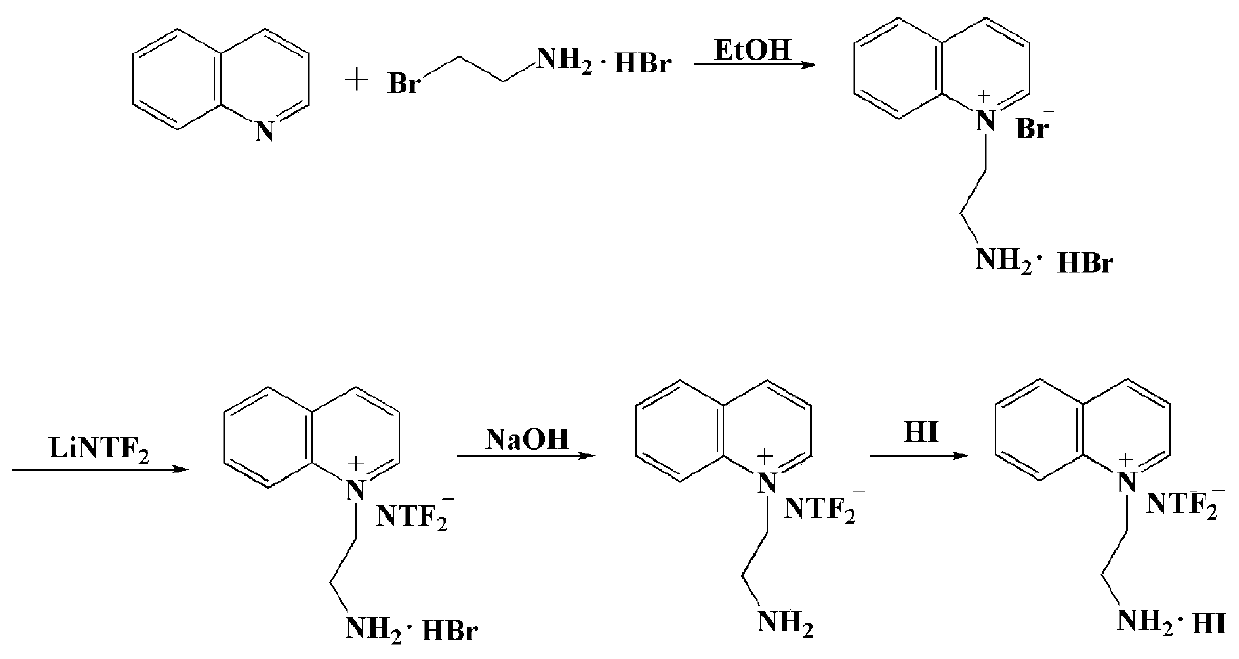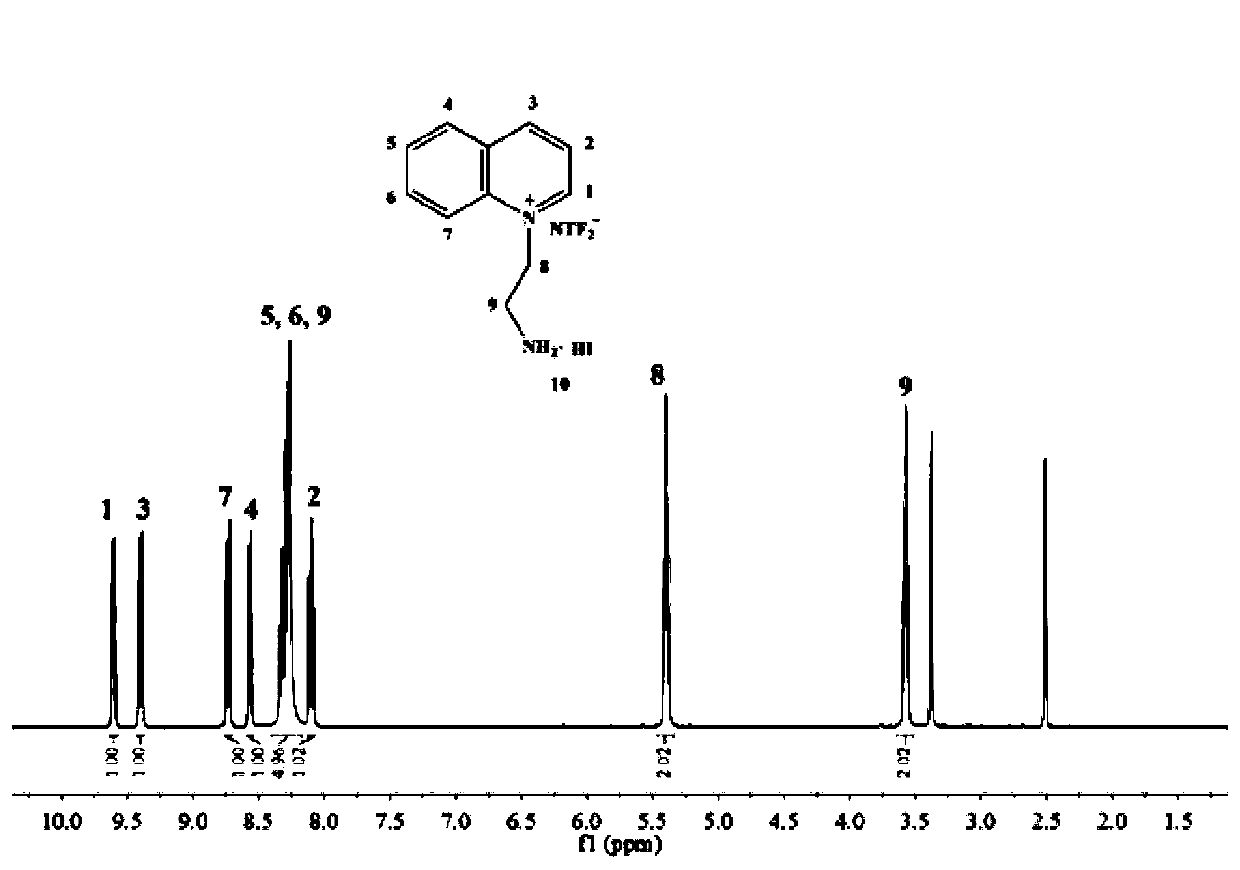Two-dimensional carbon-based perovskite solar cell based on aminoquinoline ionic liquid
A technology of solar cells and ionic liquids, applied in circuits, photovoltaic power generation, electrical components, etc., can solve the problems affecting the stability and service life of solar cell devices, hindering the commercial development of carbon-based perovskite solar cells, and the photoelectric conversion efficiency is only For 6. and other issues, to achieve good market prospects and application value, maintain long-term stability and efficiency, and accelerate the effect of commercial development
- Summary
- Abstract
- Description
- Claims
- Application Information
AI Technical Summary
Problems solved by technology
Method used
Image
Examples
Embodiment 1
[0056] like figure 1 Shown, is a kind of preparation method of hydrophobic aminoquinoline ionic liquid 1-ethylamine hydroiodide quinoline bistrifluoromethanesulfonimide salt, comprising the steps:
[0057] S1. Add 2.05g of 2-bromoethylamine hydrobromide and 1.29g of quinoline to 50ml of absolute ethanol in sequence. Under nitrogen protection, react at 75°C for 48h until a large amount of white solids are formed. After cooling to room temperature , centrifuged to remove the solvent, and the solid was washed three times with absolute ethanol to remove unreacted raw materials attached to the surface of the product, and dried in vacuum for 24 hours;
[0058] S2. Dissolve the solid product obtained in step S1 in deionized water, then add an equimolar amount of lithium bistrifluoromethanesulfonyl imide, stir and react for 4-6 hours, remove the upper aqueous phase after the reaction, and collect the oily liquid And wash with deionized water several times, and the yellow oily liquid ...
Embodiment 2
[0064] like Figure 7 As shown, this embodiment provides a two-dimensional carbon-based perovskite solar cell based on an aminoquinoline ionic liquid, and the perovskite solar cell includes a transparent conductive electrode, an electron transport layer, Mesoporous layer, perovskite light absorbing layer and counter electrode.
[0065] Wherein, the transparent conductive electrode is FTO conductive glass; the electron transport layer is TiO 2 ; The mesoporous layer is TiO 2 ; The perovskite light absorbing layer is (ILNTF 2 ) 2 (CH 3 NH 3 ) 9 Pb 10 I 31 ; The counter electrode is a carbon electrode.
[0066] The above-mentioned preparation method of a two-dimensional carbon-based perovskite solar cell based on an aminoquinoline ionic liquid comprises the following steps:
[0067] 1) Pretreatment of FTO conductive glass: ultrasonically clean the etched FTO conductive glass with deionized water, acetone, and isopropanol for 15 minutes, then blow dry with nitrogen, and ...
Embodiment 3-10
[0077] Embodiments 3-10 provide a two-dimensional carbon-based perovskite solar cell based on aminoquinoline ionic liquids. Compared with Example 2, the difference is that the preparation of the two-dimensional carbon-based perovskite solar cell is changed Method step 2) in TiO 2 The hydrothermal reaction temperature and reaction time in the preparation process of the electron transport layer, except for the above differences, other operations are the same, and will not be repeated here; the specific experimental conditions and parameters are shown in the table below.
[0078]
[0079]
[0080] The results of the photoelectric conversion efficiency of the two-dimensional carbon-based perovskite solar cell devices prepared in Examples 2 to 10 are as follows: Figure 9 As shown in (a) and (b), it can be seen from the results in the figure that the performance of the two-dimensional carbon-based perovskite solar cell device prepared when the reaction temperature is 70 °C an...
PUM
| Property | Measurement | Unit |
|---|---|---|
| Average size | aaaaa | aaaaa |
Abstract
Description
Claims
Application Information
 Login to View More
Login to View More - R&D
- Intellectual Property
- Life Sciences
- Materials
- Tech Scout
- Unparalleled Data Quality
- Higher Quality Content
- 60% Fewer Hallucinations
Browse by: Latest US Patents, China's latest patents, Technical Efficacy Thesaurus, Application Domain, Technology Topic, Popular Technical Reports.
© 2025 PatSnap. All rights reserved.Legal|Privacy policy|Modern Slavery Act Transparency Statement|Sitemap|About US| Contact US: help@patsnap.com



